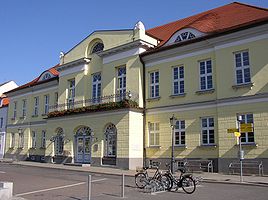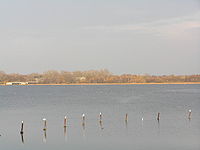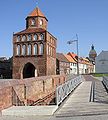- Ribnitz-Damgarten
-
Ribnitz-Damgarten Town hall 
Coordinates 54°15′0″N 12°28′0″E / 54.25°N 12.466667°ECoordinates: 54°15′0″N 12°28′0″E / 54.25°N 12.466667°E Administration Country Germany State Mecklenburg-Vorpommern District Vorpommern-Rügen Municipal assoc. Ribnitz-Damgarten Mayor Jürgen Borbe (CDU) Basic statistics Area 122.20 km2 (47.18 sq mi) Elevation 5 m (16 ft) Population 16,038 (31 December 2010)[1] - Density 131 /km2 (340 /sq mi) Other information Time zone CET/CEST (UTC+1/+2) Licence plate NVP Postal code 18311 Area code 03821 Website www.ribnitz-damgarten.de Ribnitz-Damgarten is a town in Mecklenburg-Vorpommern, Germany. It is situated at the Ribnitzer See (Lake of Ribnitz). Ribnitz-Damgarten is the largest town of the district Vorpommern-Rügen, but not its capital.
Contents
Geography
The town is situated between the two Hanseatic cities Rostock and Stralsund, on the mouth of the river Recknitz. The Ribnitzer See, into which the Recknitz empties, is a bay of the Saaler Bodden (Bay of Saal). The Saaler Bodden in turn is the south-western end of a chain of bays leading to the Baltic Sea.
Touristically relevant is Ribnitz-Damgarten's situation at the southern end of the Fischland, the peninsula dividing the chain of bays from the Baltic Sea.
History
The town's name derives in the slavic settlements Rybanis (ryba means fish) and Damgor (dam means oak tree, gora means hill), located on opposite sides of the mouth of the Recknitz river.
In ancient times, the Recknitz formed the border between Mecklenburg and Pomerania. At the ford a castle was built about 1200 on the Mecklenburg side, being the precursor of Ribnitz. The Danish princes of Rügen responded by erecting a fortress on the opposite side that later became the town of Damgarten.
Ribnitz as a town is first documented in 1233, documents point to town privileges under Lübeck law being established before 1257. Damgarten was granted such privileges in 1258 by Jaromar II, Duke of Rügen, as Damechore.[2]
In 1934, Walter Bachmann moved his airplane repair and production business from Rostock to Ribnitz. The company was specialized in seaplanes, for which nearness to open water was essential. The Walter-Bachmann-Flugzeugbau KG, as it was later called, turned the fisher's and farmer's town into a seat of war-essential production. The influx of workers for the factory, among other factors, increased the population of Ribnitz from 4772 in 1930 to 8925 in 1942.[3]
At the same time as the Bachmann works in Pütnitz, near Damgarten, an air force base was built. Like the Bachmann works for Ribnitz, so did they increase Damgarten's population, which doubled from 1933 to 1939. Primarily it was a training center for seaplane personnel.[4] After World War II, this base became one of the major deployments of the Soviet Air Forces in East Germany. 16th Guards Fighter Aviation Division of 16th Air Army was headquartered at the base from the 1950s until 1993.
On the 5th of July, 1950, the former towns of Ribnitz and Damgarten were merged. As both towns' councils had previously voted against the merger, it can be supposed that this decision was made under political pressure.[5]
Amber Town
Ribnitz-Damgarten calls itself the Bernsteinstadt (Amber Town), due to its history of manufacturing jewelry and other things from amber. With the adoption of said title came also the introduction of a new town logo, the Bernsteinlogo, which is now used on official correspondence. It can also be seen on the Stadtblatt, an informational paper issued by the town council.[6] The coat of arms shown in the information box is based on the blazon found in the Hauptsatzung (main charter) of Ribnitz-Damgarten.[7]
Today, amber is processed in the so-called Schaumanufaktur (Show Manufacture), where its processing can be watched by visitors. The resulting jewelry can also be bought. A number of shops sell amber and handicraft made of amber.
Ribnitz is home to the German Amber Museum, which is seated in the former Poor Clare Convent.[8] This museum contains a permanent exhibition that illustrates the origins and the applications of amber. Contemporary pieces of art made of amber are showcased in a separate room. A part of the museum is dedicated to the town's history.
Sights
In Ribnitz
- Marienkirche (Saint Mary's Church, 1233)
- Rostocker Tor (Rostock Town Gate, 1290)
- Klarissenkloster (Poor Clare Convent, 1323)
- German Amber Museum
In Damgarten
- Church St. Bartholomäus (St. Bartholomew)
- Bernstein-Schaumanufaktur (Amber Show Manufacture)
International relations
Main article: List of twin towns and sister cities in GermanyRibnitz-Damgarten is twinned with:
Notes
- ^ "Bevölkerungsentwicklung der Kreise und Gemeinden" (in German). Statistisches Amt Mecklenburg-Vorpommern. 31 December 2010. http://service.mvnet.de/statmv/daten_stam_berichte/e-bibointerth01/bevoelkerung--haushalte--familien--flaeche/a-i__/a123__/2010/daten/a123-2010-22.pdf.
- ^ Erichson, H.: Zur Geschichte der Städte Ribnitz und Damgarten von der Gründung im 13. Jahrhundert bis zum Zusammenschluß im Jahre 1950. Ribnitz-Damgarten 1997. pp. 19-26
- ^ ibid.: pp. 230-232
- ^ ibid.: pp. 235-236
- ^ ibid.: pp. 262
- ^ "Stadtblatt Bernsteinstadt Ribnitz-Damgarten Nr. 29" (PDF). December 2006. http://www.ribnitz-damgarten.de/fileadmin/pdf/stadtblatt/buntes/RDG_Stadtblatt_Nr.29.pdf. Retrieved 2007-03-19.
- ^ "Hauptsatzung der Stadt Ribnitz-Damgarten." (PDF). 2005-01-01. pp. §2, 2nd par.. http://www.ribnitz-damgarten.de/fileadmin/pdf/satzungen/Hauptsatzung.pdf. Retrieved 2007-09-04.[dead link]
- ^ Ulpts, Ingo: Die Bettelorden in Mecklenburg. Ein Beitrag zur Geschichte der Franziskaner, Klarissen, Dominikaner und Augustiner-Eremiten im Mittelalter. Werl 1995 (Saxonia Franciscana 6).
External links
- Town of Ribnitz-Damgarten
- (German) The German Amber Museum's homepage
- Google Map of Ribnitz, Damgarten and Pütnitz
Geography of Pomerania Regions CurrentVorpommern (Western or Hither Pomerania) · Zachodniopomorskie · Pomerelia (Kashubia) · Pomerania euroregionAdministration Towns ListsList of towns in Vorpommern · List of towns in Farther Pomerania · Pomeranian cities, towns and villages · List of placenames in the Province of Pomerania (A-H · I-P · Q-Z)Largest>100,000>50,000Islands Peninsulae Rivers Lakes Bays, lagoons National parks History of Pomerania 10,000 BC–600 AD · 600–1100 · 1100–1300 · 1300–1500 · 1500–1806 · 1806–1933 · 1933–1945 · 1945–presentAdministrative Billung March · Northern March · Principality of Rugia ·
Duchy of Pomerania (House of Pomerania · List of Dukes · Cammin · Gützkow · Schlawe-Stolp · Lauenburg-Bütow · Partitions · P.-Stolp) · Swedish Pomerania · Brandenburgian Pomerania (Draheim)
Pomerania Province (1815-1945) (Neumark · Posen-West Prussia · List of placenames) · Mecklenburg-VorpommernZachodniopomorskie
(after 1945)Medieval duchies (Samborides) · State of the Teutonic Order · Royal Prussia (Pomeranian Voivodeship (1466–1772)) · Free City of Danzig (1807–14) · West Prussia · Pomeranian Voivodeship (1919–39) (Polish Corridor) · Free City of Danzig (1920–39) · Reichsgau Danzig-West Prussia · Pomeranian Voivodeship (Kashubian placenames)Ecclesiastical Conversion of Pomerania · Diocese of Kolberg (hist.) (Congress of Gniezno) · Diocese of Cammin (hist.) Diocese of Culm (hist.) · Diocese of Roskilde (hist.) · Diocese of Włocławek (Leslau) (hist.) · Prelature of Schneidemühl (hist.)
Archdiocese of Berlin · Archdiocese of Szczecin-Kamień · Diocese of Koszalin-Kołobrzeg · Diocese of PelplinProtestant Reformation · Evangelical State Church in Prussia (hist.) · Pomeranian Evangelical Church ·Demography Archaeological
culturesHamburg · Maglemosian · Ertebølle-Ellerbek · Linear Pottery · Funnelbeaker · Havelland · Corded Ware · Comb Ceramic · Nordic Bronze Age · Lusatian · Jastorf · Pomeranian · Oksywie · Wielbark · Gustow · Dębczyn (Denzin)PeoplesGepids · Goths · Lemovii · Rugii · Vidivarii · Vistula Veneti ·
Slavic Pomeranians · Prissani · Rani · Ukrani · Veleti · Lutici · Velunzani ·
German Pomeranians · Kashubians · Poles · SlovinciansMajor demographic
eventsLanguages
and dialectsTreaties Kremmen (1236) · Landin (1250) · Kępno (1282) · Soldin (1309) · Templin (1317) · Stralsund (1354) · Stralsund (1370) · Thorn (1411) · Soldin (1466) · Thorn (1466) · Prenzlau (1448/72/79) · Pyritz (1493) · Grimnitz (1529) · Stettin (1570) · Franzburg (1627) · Stettin (1630) · Westphalia (1648) · Stettin (1653) · Labiau (1656) · Wehlau and Bromberg (1657) · Oliva (1660) · Saint-Germain-en-Laye (1679) · Lund (1679) · Stockholm (1719/1720) · Frederiksborg (1720) · Kiel (1814) · Vienna (1815) · Versailles (1919) · Potsdam (1945)Categories:- Towns in Mecklenburg-Vorpommern
Wikimedia Foundation. 2010.







